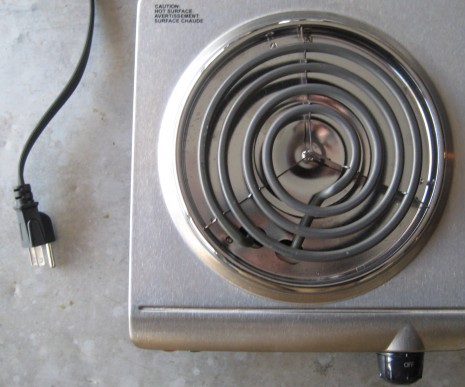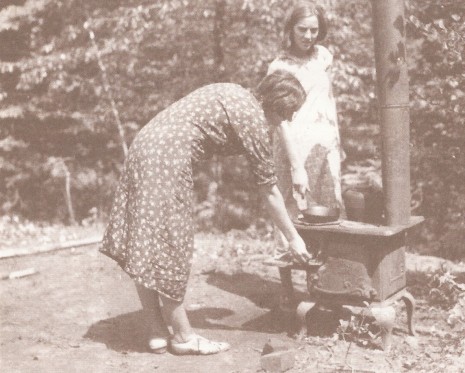COOKING ON ONE BURNER
Recently, our stove, an increasingly temperamental 35-year-old Imperial range, busted. I mean, really busted. My husband, Sam, and I were philosophical about this turn of events, having seen it coming a mile off. In fact, we’ve talked about a modest renovation of our postage stamp–sized kitchen (it’s 6 by 8 feet, minus appliances and counter) for so long, it’s become a running joke among family and friends. Sam would tell you the axiom “If it ain’t broke, don’t fix it” is just another way to describe Newton’s First Law of Motion. I would add that inertia is very, very comfortable. Until it’s not.
Now that we’ve been forced into action, we are almost giddy with excitement, and we’re making decisions that once seemed overwhelming with confidence and ease. In record time, we’ve had new flooring installed (real linoleum that’s so pretty I want to curl up and sleep on it) and are putting the finishing touches on freshly painted walls before taking delivery of the new stove (with a snazzy over-the-range microwave) and refrigerator (in for a penny, in for a pound). I’ll bet Sam, who has orchestrated almost everything, is going to pass out cigars at the end of it all.
Which I’m hoping is soon. Most of the kitchen’s contents are taking up a good bit of real estate in the living room, and the piles have grown increasingly disorganized. My favorite cutting board, for instance, has gone missing. A 10-minute search happily revealed the pepper mill, though, which disappeared days ago. For some reason, I had tucked it in the bread box, under a chair. Since we’re out of bread, I really have no idea why I was even looking for a cutting board in the first place.
When the Imperial gave up the ghost, I bought an inexpensive hot plate, thinking it would come in handy for coffee and tea. It turned out to be the smartest purchase I’ve made in a long time, for I failed to realize just how quickly we’d tire of sandwiches and take-out meals, or needing, instead of wanting, to go out for dinner.
We’ve used the hot plate for reheating leftovers and for making fried rice, a couple of pan-fried blade steaks, and a quick-cooking lentil soup. But although you would think that with the brand name “Toastess,” it would be good at, well, toasting, think again. For yesterday’s grilled cheese sandwiches, I would have been better off using a technique pioneered by our friend Rick Ellis, a food stylist who often finds himself alone in a hotel room with great ingredients and no way to cook them. Rick, the son of a Marine, is one of the most resourceful people I know. “Grilled cheese?” he said. “Plug in the iron and use a sheet of aluminum foil!” I’ll bet he would get along well with the two stalwart souls in the photo below, published in Camp Cooking: 100 Years, from the National Museum of Forest Service History, in Missoula, Montana.
The spiral-bound collection of recipes is a great example of why you should never pass up the chance to visit a museum gift shop. It includes archival journal entries and photographs from fire fighters, young men from the Civilian Conservation Corps, tourists visiting Yellowstone and Pike’s Peak circa 1924, and, of course, park rangers and their extraordinary wives.
In the winter of 1916, one ranger and his bride made their home in a cabin in Utah’s Wasatch National Forest. The temperature was 32 degrees below zero, and a morning fry-up started with “peeling the shell from a frozen egg, dropping it in the skillet, and waiting for it to thaw out.” Yikes.
Sprinkled throughout the book is terse advice on everything from maintaining a sourdough starter to cooking rolls or biscuits in a Dutch oven. “Buy a small aluminum cake pan that will fit inside your oven,” an experienced baker instructs. “Place 3 nickels in the bottom of the oven and then place the pan with the rolls on these (holds the pan up so the bottom of the rolls don’t burn).”
I learned that the blade of a long-handled shovel can double as a fry pan and how to start a fire with two flashlight batteries and steel wool. “This method works very well for starting a fire in windy areas,” I read, completely absorbed. “For safety reasons, always pack batteries and steel wool in separate containers.” Perhaps this book doesn’t belong on the shelf, but in the hurricane/black-out/terrorist attack/earthquake emergency bin in the linen closet. “At least it won’t end up in the breadbox,” Sam muttered.
As much as I’d like to try McDuff’s Dutch Oven Roast (Venison, Elk, or Moose), Pioneer Night Stew (moose, again), or a butterless, milkless, eggless Canyon Cake (made by generations of a ranger family who packed it on horseback throughout the backcountry of the Cache, Humboldt, Salmon, Challis, Sawtooth, and Targhee national forests), I think I’d better keep it simple. Last week, my One-Eyed Buffaloes (a.k.a. Toads-in-a-Hole) were a great success, although we had to eat in shifts. Tonight we’re having eggs again, and I can almost smell the woodsmoke.
Camper’s Omelet
Adapted from Camp Cooking: 100 Years by the National Museum of Forest Service History
This recipe was contributed by Jim Hasbrouck, from the Forest Service’s Region 8, which stretches from Virginia and North Carolina to Texas. It makes a hearty supper for two people who haven’t eaten since breakfast.
½ pound bacon
2 medium potatoes, unpeeled and chopped
1 medium onion, chopped
½ medium onion, chopped
½ bell pepper, chopped
6 eggs (whisked fluffy)
1 tomato (optional), sliced
½ pound extra-sharp Cheddar, grated
1. Fry bacon until crisp in a cast-iron skillet. Remove bacon and fry potatoes in grease until tender; throw in onion and bell pepper.
2. When onion appears cooked, reduce heat to pan by turning down campstove burner. Pour in eggs and cover for 3 to 5 minutes, stirring occasionally to avoid scorching. Place tomato slices, cheese, and crumbled bacon on top. Cover again for a few minutes until cheese melts and the tomatoes are smiling.
3. Remove from fire, slice into wedges, and serve with hot sauce.
Posted: January 17th, 2012 under cookbooks, kitchen equipment, recipes.



